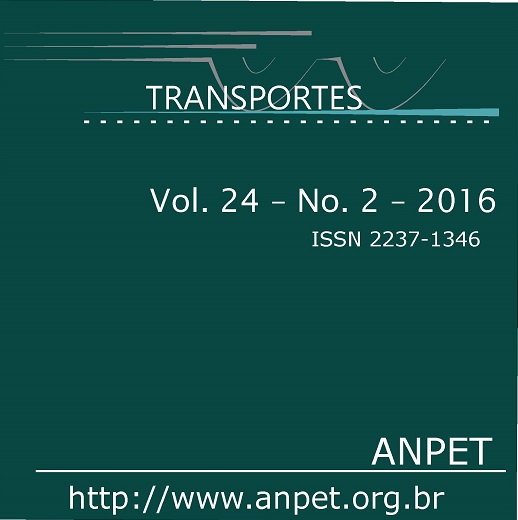A produção científica em Logística Humanitária no século XXI: uma análise bibliométrica
DOI:
https://doi.org/10.14295/transportes.v24i2.883Palavras-chave:
Logística Humanitária, Revisão Bibliográfica, Análise Bibliométrica, Análise de Redes Sociais.Resumo
A logística humanitária obteve reconhecimento público de seu papel nas operações de resposta a desastres após o tsunami no Oceano Índico (2004), e, desde então, tem despontado como um novo campo de pesquisa. Dez anos após esta catástrofe, o presente artigo apresenta um estudo bibliométrico, com o objetivo de analisar o crescimento do conhecimento e identificar as tendências da comunicação escrita no ramo da Logística Humanitária nesta última década. O escopo da pesquisa consistiu em realizar uma análise estatística, integrando métodos bibliométricos e técnicas de análise de redes sociais, para proporcionar uma melhor compreensão do campo. A busca a partir de palavras chaves identificou 312 artigos publicados em revistas internacionais que foram analisados de acordo com diversos critérios com intuito de identificar um perfil do estudo em logística humanitária. Embora os resultados apresentados neste trabalho indiquem uma tendência crescente de estudos na área de logística humanitária a nível internacional, no campo nacional esta é ainda incipiente. A análise bibliométrica possibilitou obter uma melhor compreensão dos principais temas, conceitos e relações ligadas à ajuda humanitária. Como pode ser observado, houve uma forte tendência na direção dos estudos para o campo da pesquisa operacional. Os resultados sugerem que grande parte das pesquisas desenvolvidas até o momento apoia-se em bases teóricas relacionadas à problemas de redes (de localização e roteirização), à teoria da decisão (processo decisório e sistemas de suporte a decisão) e à gestão de riscos.
Downloads
Referências
APTE, A. (2009). Humanitarian logistics: A new field of research and action. Foundations and Trends in Technology, Information and Operations Management 3(1): 1-100.
ARAÚJO, C.A. (2006). Bibliometria: evolução histórica e questões atuais. Em questão. Porto Alegre, v. 12, n. 1, p.11-32, Jan / Jun. Available at: <http://revistas.univerciencia.org/index.php/revistaemquestao/article/viewFile/3707/3495>. Accessed in november 25, 2013.
BALCIK, B.; BEAMON, B.M.; KREJCI, C.C.; MURAMATSU, K.M.and RAMIREZ, M. (2010). Coordination in humanitarian relief chains: Practices, challenges and opportunities. International Journal Production Economics. Science Direct, 126 (1), pp.22-34.
BASTOS, M.; CAMPOS, V.; BANDEIRA, R. Logistics processes in a post-disaster relief operation. Procedia – Social and Behavioral Sciences, V. 111, n. 5, p. 1175-1184.
BEAMON, B., KOTLEBA, S. (2006). Inventory modeling for complex emergencies in humanitarian relief operations. International Journal of Logistics: Research and Applications, v. 9, n. 1, p. 1-18.
BERTAZZO, T., BRITO JUNIOR, I., LEIRAS, A. e YOSHIZAKI,H. (2013) Revisão da literatura acadêmica brasileira sobre a gestão de operações em desastres naturais com ênfase em logística humanitária. Transportes, v. 21, n.3, p. 31-39.
CAMPOS, V.; BANDEIRA, R.; BANDEIRA, A. A method for evacuation route planning in disaster situations. Procedia – Social and Behavioral Sciences, V. 54, n. 5, p. 503-512.
CELIK, M.; ERGUN, O.; JOHNSON, B.; KESKINOCAK, P.; LORCA, A.; PEKGUN, P. and SWANN, J. (2012) Humanitarian Logistics.Tutorial in Operations Reserch – Informs.
COSTA, S.; BANDEIRA, R.A.M.; CAMPOS, V.; BANDEIRA, A.P.F. Revisão sobre modelagem matemática na logística humanitária. Transportes, v. 22, n. 2, p. 70-84.
COSTA, S.; CAMPOS, V.; BANDEIRA, R. (2012) Supply Chains in Humanitarian Operations: Cases and Analysis Original. Procedia - Social and Behavioral Sciences, V. 54, p. 598-607.
COZZOLINO, A. (2012). Humanitarian Logistics, SpringerBriefs in Business.
ERTEM, M., BUYURGAN, N. and ROSSETTI, M. (2010). Multiple-buyer procurement auctions framework for humanitarian supply chain management. International Journal of Physical Distribution & Logistics Management, v. 40, n. 3, p. 202-227.
GUNHA-SAPIR, D.; HOYOIS, P. e BELOW, R. (2013). Annual Disaster Statistical Review 2012: The numbers and trends. Centre for Research on the Epidemiology of Disasters. Brussels: CRED; 2013. Available at: <http://cred.be/sites/default/files/ADSR_2012.pdf>. Accessed in november 13, 2013.
JAHRE. M, JENSEN, L, LISTOU, T. (2009) Theory Development in humanitarian logistics: a framework and three cases. Management Research News, v. 32, m. 11, pp. 1008-23.
KENT, R. (2004). International humanitarian crises: two decades before and two decades beyond. International affairs, v. 80, n. 5, pp.153-72.
KOVACS, G. e SPENS, K. (2007). Humanitarian logistics in disaster relief operations. International Journal of Physical Distribution & Logistics Management, v. 37, n. 2, p. 99-114.
KOVACS, G., SPENS, K. (2009). Identifying challenges in humanitarian logistics. International Journal of Physical Distribution & Logistics Management, v. 39, n. 6, p. 506-528.
LAVELL, A. (2003). Gestión Local del riesgo. Nociones y precisions en torno al conceptoy la práctica, CEPREDEAC-PNUD.
NATARAJARATHINAM, M.; CAPAR, I. E NARAYANAN, A. (2009) Managing supply chains in times of crisis: a review of literature and insights. International Journal of Physical Distribution and Logistics Management 39(7), 535-573.
NICHOLSON, A. (2003) Transport network reliability measurement and anal-ysis. Revista Transportes. v. 11, p. 49–62.
NIELSEN, L. (2011). Classifications of Countries Based on Their Level of Development: How it is Done and How it Could be Done. International Monetary Fund.Available at: <http://www.relooney.fatcow.com/0_NS4053_1504.pdf>. Accessed in november 28, 2013.
NOGUEIRA,C.; GONÇALVES, M. e NOVAES A. (2008) Logística humanitária e Logística empresarial: Relações, conceitos e desafios. Novembro. Rio de Janeiro.
ONU BR (2012): Rio+20 O futuro que queremos. Fato sobre Desastres, junho. Brasil. Available at: <http://www.onu.org.br/rio20/desastres.pdf>. Accessed in november 7, 2013.
OVERSTREET, R., HALL, D., HANNA, J., RAINER, K.(2011) Research in humanitarian logistics. Journal of Humanitarian Logistics and Supply Chain Management, v.1, n. 2., pp. 114-31.
THOMAS, A.; MIZUSHIMA, M. (2005). Logistics training: necessity or luxury? Forced Migration Review 22(1):60-61.
THOMAS, A.S. (2003) Humanitarian Logistics: Enabling Disaster Response. Fritz Institute.
THOMAS, A.S. e KOPCZAK, L.R. (2005) From Logistics to Supply Chain Management: The Path Forward in the Humanitarian Sector. Fritz Institute.
TRUNICK, P. (2005). Special report: delivering relief to tsunami victims. Logistics Today, Vol. 46 No. 2, pp. 1-3.
VAN WASSENHOVE, L. (2006) Humanitarian aid logistics: supply chain management in high gear. Journal of the Operational Research Society. 57, 475-498.
VAN WASSENHOVE, L. N.; TOMASINI, R. (2009). Humanitarian logistics. Insead Business Press.
VAN WASSENHOVE, L.N. (2006). Humanitarian aid logistics: supply chain management in high gear. Journal of Operational Research Society 57 (5) 475–489, 2006.
WATANUKI, H.; NADAE, J.; CARVALHO, M. MORAES, R. (2014) Gestão de projetos internacionais: um estudo bibliométrico. Gestão & Produção , 21 ( 3), 660-675.
Downloads
Publicado
Como Citar
Edição
Seção
Licença
Ao submeter um manuscrito para publicação neste periódico, todos os seus autores concordam, antecipada e irrestritamente, com os seguintes termos:
- Os autores mantém os direitos autorais e concedem à Transportes o direito de primeira publicação do manuscrito, sem nenhum ônus financeiro, e abrem mão de qualquer outra remuneração pela sua publicação pela ANPET.
- Ao ser publicado pela Transportes, o manuscrito fica automaticamente licenciado sob a Licença Creative Commons CC BY 4.0. Esta licença permite o seu compartilhamento com reconhecimento da autoria e da publicação inicial neste periódico.
- Os autores têm autorização para assumir contratos adicionais separadamente, para distribuição não exclusiva da versão do trabalho publicada neste periódico (por ex.: publicar em repositório institucional ou como capítulo de livro), com reconhecimento da publicação inicial na Transportes, desde que tal contrato não implique num endosso do conteúdo do manuscrito ou do novo veículo pela ANPET.
- Os autores têm permissão e são estimulados a publicar e distribuir seu manuscrito online (por ex.: em repositórios institucionais ou na sua página pessoal) depois de concluído o processo editorial. Como a Transportes é de acesso livre, os autores são estimulados a usar links para o DOI do artigo nesses casos.
- Os autores garantem ter obtido a devida autorização dos seus empregadores para a transferência dos direitos nos termos deste acordo, caso esses empregadores possuam algum direito autoral sobre o manuscrito. Além disso, os autores assumem toda e qualquer responsabilidade sobre possíveis infrações ao direito autoral desses empregadores, isentando a ANPET e a Transportes de toda e qualquer responsabilidade neste sentido.
- Os autores assumem toda responsabilidade sobre o conteúdo do manuscrito, incluindo as devidas e necessárias autorizações para divulgação de dados coletados e resultados obtidos, isentando a ANPET e a Transportes de toda e qualquer responsabilidade neste sentido.










